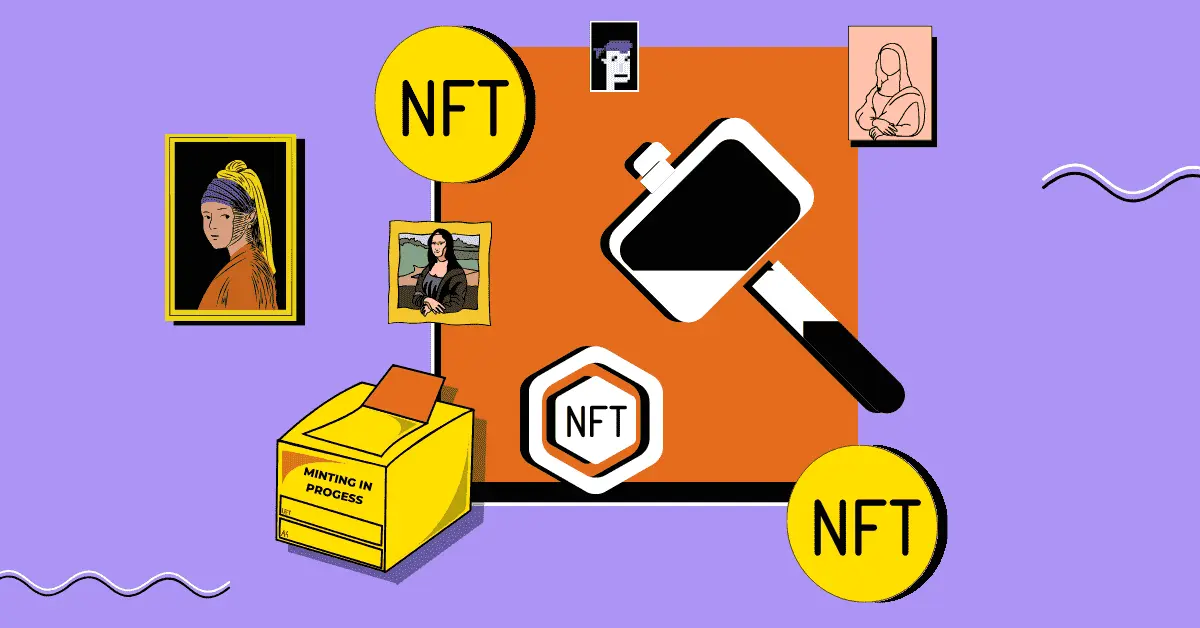
Have you ever wondered how people turn their digital creations into NFTs and sell them for cryptocurrency? It might sound like rocket science, but trust me, it’s not.
By the end of this guide, you’ll know how to mint your own NFT step by step.
Let’s start with the basics. NFT stands for Non-Fungible Token.
It is a fancy term. But all it means is that it’s a unique digital asset. Think of it like a rare trading card or a one-of-a-kind painting, but digital. Each NFT is different and can’t be swapped one-for-one like Bitcoin or dollars.
The coolest part? NFTs can be anything digital – art, music, videos, memes, even tweets! In fact, Twitter’s co-founder sold his first-ever tweet as an NFT for millions.
But enough about the hype.
Let’s get to the real deal – how you can create and mint an NFT.
Minting is just a crypto way of saying you’re creating an NFT and adding it to a blockchain. Think of it like publishing a book. When you mint an NFT, you’re making your digital creation official and unique, giving it proof of ownership and authenticity.
How do we do that?
Before anything else, decide what you want to turn into an NFT.
It could be:
Example: Let’s say you’re a photographer. You have a stunning sunset photo that you think people might love. That could be your NFT!
Pro Tip: Make sure you own the rights to whatever you’re minting. Don’t use someone else’s work unless you have permission.
Next, you need to choose a blockchain to host your NFT. Blockchains are like the foundation where your NFT lives.
The most popular blockchain for NFTs is Ethereum, but there are others like:
Each has its pros and cons. For example:
If you’re unsure, Ethereum is a safe choice because it’s widely used.
You’ll need a digital wallet to store cryptocurrency and manage your NFTs. Think of it as your digital purse.
Popular wallets include:
Set up your wallet (it’s free) and save your recovery phrase. This phrase is like the key to your safe. Lose it, and you lose access to your wallet. Seriously, don’t skip this step.
Now that you have a wallet, you’ll need some cryptocurrency to cover fees. The amount depends on the blockchain you choose.
For Ethereum, you’ll need ETH. For Solana, you’ll need SOL. You can buy crypto on exchanges like Coinbase, Binance, or Kraken. Once you’ve got your crypto, transfer it to your wallet.
Example: If you’re minting on Ethereum, you might need $50 to $100 worth of ETH to cover fees.
This is where the magic happens. Marketplaces are platforms where you can mint, showcase, and sell your NFTs.
Some popular ones are:
Each platform has its vibe. OpenSea is a great starting point because it’s user-friendly and supports Ethereum and Polygon.
Now comes the fun part – creating your NFT!
Here’s how it usually works:
Once done, your NFT is minted! And, you’re officially an NFT creator.
You can stop at minting, or you can go a step further and sell your NFT. Here’s how:
Example: Let’s say you set the price for your “Golden Sunset” NFT at 0.1 ETH (~$160). Now, anyone who loves it can buy it directly from the marketplace.
It depends on the blockchain. On Ethereum, it can range from $20 to $200, depending on network traffic. Other blockchains like Solana are much cheaper.
Some platforms offer “lazy minting,” where you don’t pay upfront fees. Instead, the buyer pays when they purchase your NFT.
Not at all! Most marketplaces are user-friendly and require no technical knowledge.
Don’t worry. NFTs are like any art form. It takes time, promotion, and the right audience.
Minting an NFT might seem like a big deal, but it’s easier than you think. All it takes is the right tools, a bit of creativity, and some patience. Whether you’re an artist, musician, or just curious, NFTs open up a world of possibilities.
So, what will your first NFT be? Start creating, and who knows? Your digital masterpiece might just be the next big thing!
Minting an NFT means creating a unique digital asset and adding it to a blockchain to prove ownership and authenticity.
The cost depends on the blockchain; Ethereum fees can range from $20 to $200, while Solana is usually cheaper.
Some platforms offer “lazy minting,” where the buyer pays the minting fees when they purchase your NFT.
Once minted, list your NFT for sale on a marketplace, set a price, and promote it on social media or other platforms.
CoinPedia has been delivering accurate and timely cryptocurrency and blockchain updates since 2017. All content is created by our expert panel of analysts and journalists, following strict Editorial Guidelines based on E-E-A-T (Experience, Expertise, Authoritativeness, Trustworthiness). Every article is fact-checked against reputable sources to ensure accuracy, transparency, and reliability. Our review policy guarantees unbiased evaluations when recommending exchanges, platforms, or tools. We strive to provide timely updates about everything crypto & blockchain, right from startups to industry majors.
All opinions and insights shared represent the author's own views on current market conditions. Please do your own research before making investment decisions. Neither the writer nor the publication assumes responsibility for your financial choices.
Sponsored content and affiliate links may appear on our site. Advertisements are marked clearly, and our editorial content remains entirely independent from our ad partners.
XRP price has struggled to move higher even as XRP exchange traded funds continue to…
Bitcoin price continues to move sideways after a quiet weekend, showing little momentum in either…
Interest in XRP exchange traded funds is growing quickly after another product received approval. Cboe…
Investors searching for the next high-upside opportunity are now comparing this $0.035 emerging crypto to…
The LINK price remains capped and under bearish pressure despite there being strong signs of…
Strategy, the company led by Bitcoin advocate Michael Saylor, has successfully held its place in…